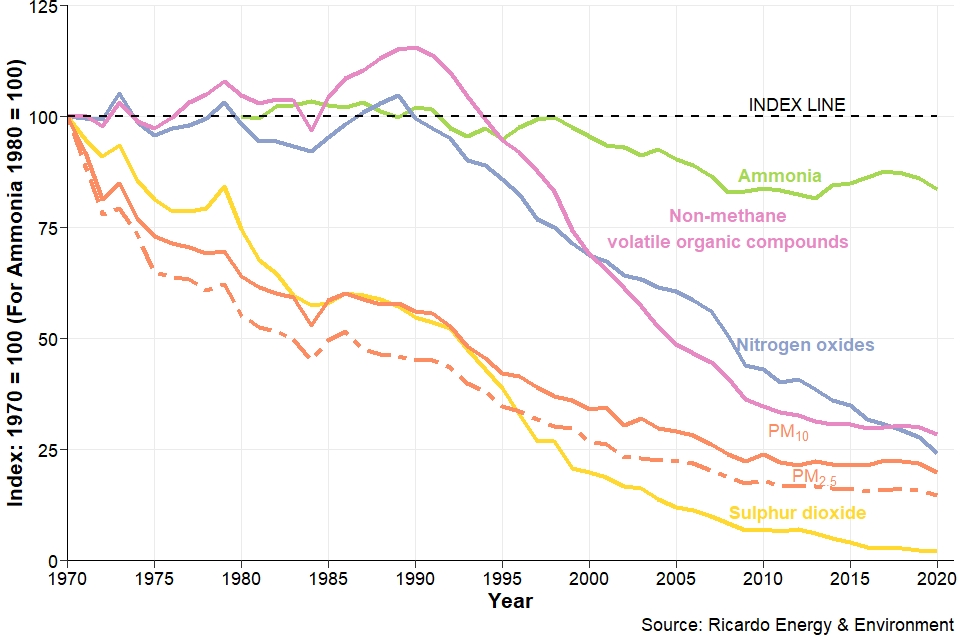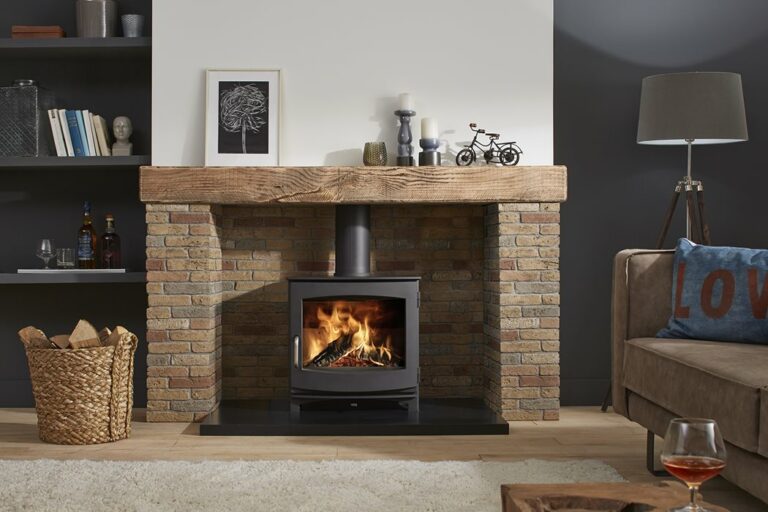
National statistics of emissions of air pollutants
On the 18th February 2022 Defra published its emissions of air pollutants national statistics. The publication provides estimates of UK emissions of particulate matter (PM10 and PM2.5), nitrogen oxides, ammonia, non-methane volatile organic compounds and sulphur dioxide. The information contains statistics on annual emissions for the period 1970 to 2020.
The full set of emissions of air pollutants national statistics can be viewed on the .GOV website.
These statistics are used to monitor progress against the UK’s emissions reduction targets for air pollutants. Emissions reductions in the UK contribute to improvements in air quality in the UK alongside a number of other factors. More detailed emissions totals are available on the NAEI website each year in the summer. Emissions maps and emission totals for each of the four administrations of the UK (England, Scotland, Wales, Northern Ireland) are published in the autumn.
The headline message is that there has been a long-term decrease in the emissions of all of the air pollutants covered by the latest statistical release (ammonia, nitrogen oxides, non-methane volatile organic compounds, particulate matter [PM10, PM2.5] and sulphur dioxide). The UK has met current domestic and international ceilings for emissions of nitrogen oxides, non-methane organic compounds, PM2.5 and sulphur dioxide, but has exceeded the 2020 target for ammonia.
Annual emissions of PM2.5 have fallen by 85 per cent since 1970, to 80.1 thousand tonnes in 2020. There was a decrease of 7 per cent between 2019 and 2020.
A large number of factors are responsible for the long-term decrease in emissions of air pollutants:
- The reduction in use of coal for domestic heating and power generation has been a major factor in reducing emissions of particulate matter, although burning of other solid fuels for domestic heating and industry has increased in recent years.
- The move away from using coal to gas for power generation and fitting flue gas desulphurisation equipment to existing coal-fired power stations has been responsible for long-term decreases in emissions of sulphur dioxide and nitrogen oxides.
- Stricter emissions regulation for road transport has also led to significant emissions reductions for nitrogen oxides and non-methane volatile organic compounds (NMVOCs).
- Stricter emissions limits placed on industry has significantly reduced emissions from solvents, which particularly affected emissions of NMVOCs.
- Emissions of ammonia were largely influenced by changes to herd sizes and farming practices, as emissions from agriculture form the majority of emissions of ammonia.

Particulate Emissions
There has been a focus on particulate emissions from domestic combustion for some time now. Previous statistical releases have estimated that the emissions from domestic combustion was higher across the whole time series. The Digest of UK Energy Statistics (DUKES), produced by BEIS, is a key data source used to produce these emission estimates, and has been updated with revised estimates of fuel use in the domestic combustion sector. Applying the revised data taken from a more recent Kantar report has reduced emission estimates from domestic burning across the time series. The old 38% figure that HETAS disputed, along with industry, for some time has been superseded in light of the newer data. Emissions of PM2.5 from domestic wood burning are now reported as 17 percent of total PM2.5. emissions in 2020.
Kantar Research
Defra undertook further research with to gain a better understanding of burning in UK homes and gardens. The research was carried out by Kantar, a specialist organisation in data and research. The research was designed to update understanding of how much solid fuel burning is happening domestically in the UK, including non-wood solid fuels and burning outdoors in gardens. The in depth research looks at wide ranging factors for both indoor and outdoor burning; ownership of appliances, the role of solid fuel heating systems, types of appliances & fuels. In addition to sourcing fuels, burning practices, who burns and the views of non-burners.
Find out more about the research undertaken by Kantar here.
Combustion in the manufacturing and construction sector was a major source of particulate matter emissions, accounting for 27 per cent of PM2.5 emissions and 16 per cent of PM10 emissions in 2020. Industrial combustion and processes are another major source of particulate matter emissions, together accounting for 34 percent of PM10 and 14 percent of PM2.5 in 2020.
Changing regulation
With wood burning proving to be a popular choice of heating in the last decade, the report suggests that PM2.5 from domestic wood burning increased between 2010 and 2020. This demonstrates that as a sector we must continue to find ways to reduce the impact on air quality from wood burning, driving better appliances that are using the best fuels, regular sweeping and servicing and making sure everyone using their stove does so in the best possible way. Legislation such as Ecodesign and The Air Quality (Domestic Solid Fuels Standards) (England) Regulations 2020 have already brought about change and we can expect further announcements in Wales and Scotland as their clean air plans progress over the coming months.
Consumers can already make informed choices on fuels for immediate use by looking for the Ready to Burn certification mark on wood and solid fuel packaging. Search for Ready to Burn woodfuels on the Woodsure website or check Ready to Burn solid mineral fuels on the Defra Authorised fuels list.
Environment Act
Additionally, the Environment Act 2021 became law on the 9th November 2021. The Act was approved after being first introduced to Parliament in January 2020 to address environmental protection and the delivery of the Government’s 25-year environment plan following Brexit. The Act includes the setting of new legally binding long-term targets to improve air quality and reduce fine particulate (PM2.5) emissions by October 2022. It also makes it quicker and easier for local authorities to enforce penalties for smoke emissions from homes in a Smoke Control Area (SCA), and removes the limits on fines that can be issued for the sale and delivery of unapproved solid fuels to a building in an SCA. Retailers of solid fuel will also be required to tell customers that it is illegal to buy unapproved fuel for use in an SCA, unless they’re using an exempted appliance which lists that fuel as acceptable for use.
Cleaner Choice
HETAS is committed to promoting a reduction in emissions and we want to recognise stoves and boilers that far exceed Ecodesign requirements. HETAS has introduced the new Cleaner Choice appliance Approval Scheme focused on raising industry standards and driving consumers towards the cleanest burning biomass and solid fuel appliances proven to go above and beyond in minimising harmful particle emissions, reducing the impact of their use on air quality and the environment.
The scheme has set a lower level of particulate emissions than the most stringent legislation requires within current Smoke Control Areas. This now means that a stove must meet both the current requirements for exemption and have attained listing on the DEFRA website, whilst also achieving at least a 50% improvement on current particulate limits for exemption, when measured using the more robust test methodology recognised within the UK.
In doing this we hope to demonstrate to buyers that appliances can be used to burn fuels responsibly and operated in a way that reduces smoke (particulate) emissions. For biomass boilers, already having greater levels of combustion controls, they must demonstrate that they too meet the same stringent emissions standards and are exempted for use in smoke control areas where legally required.



